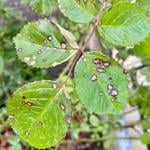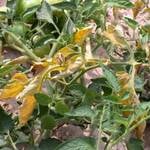
How to Grow Passionfruit Seeds
Grow Guide #2301
Family: Passifloraceae
Binomial name: Passiflora sp.
Life Cycle: Perennial
This 'How to Grow' guide details everything a home gardener needs to know to plant, grow and care for Passionfruit (Passiflora sp.).
When to Sow Passionfruit Seeds
Passionfruit is a warm season crop. Use the table below to identify the best time of year to sow passionfruit seeds in your climate.
| JAN | FEB | MAR | APR | MAY | JUN | JUL | AUG | SEP | OCT | NOV | DEC | |
|---|---|---|---|---|---|---|---|---|---|---|---|---|
| Cool | ||||||||||||
| Temperate | ||||||||||||
| Sub-Tropical | ||||||||||||
| Tropical | ||||||||||||
| Arid |
Preparation
Passionfruit plants are perennial, meaning they live for several years. Choose a permanent position where plants can grow undisturbed by regular digging.
Passionfruit plants are best grown in full sun. Choose a location that will receive at least 6 hours of full sun each day.
Passionfruit plants need a well drained soil enriched with plenty of organic matter. Prepare soil by weeding it thoroughly, digging it over to loosen it and adding aged animal manure or compost. Keep the area free of weeds until planting. Learn more about preparing soil for planting here.
How to Sow Passionfruit Seeds
Scarifying seeds prior to planting will improve the speed and success of germination. Scarification involves intentionally damaging the hard outer coating of the seeds to allow water to reach the seed's embryo. Use a sharp knife to make a shallow nick in each seed's shell, or gently wear away a section of the husk using fine sandpaper or a nail file. Read more about scarification here.
Passionfruit seeds can be sown directly into the garden OR seedlings can be raised in trays or other containers and transplanted to the garden once established.
Sow Direct
- Sow seeds directly in the garden 8mm deep and 200cm apart, with rows 200cm apart.
- Keep soil moist but never wet or dry.
- Seeds should germinate in around 21-84 days at a soil temperature of 20-30°C.
- Young seedlings will need protection from pests, pets and weather until they are established.
Raise Seedlings
- Fill trays, punnets or jiffy pots with a good quality seed-raising mix, or use soil starter pellets.
- Sow seeds 8mm deep.
- Keep soil moist but never wet or dry.
- Seeds should germinate in around 21-84 days at a soil temperature of 20-30°C.
- Transplant seedlings to the garden once they have their first true leaves and are large enough to handle (usually 5-10cm tall).
- Plant out, spacing plants 200cm apart, with rows 200cm apart.
Passionfruit is a tender crop that’s sensitive to frost. Do not transplant seedlings or sow seeds outside until all danger of frost has passed.
Tip: Seeds of this variety can be slow to germinate. Take note of the expected germination time, be patient and follow the recommended depth and temperature guidelines closely for the best chance of success.
How to Grow Passionfruit
Passionfruit plants may need watering during the growing season. Water when the soil is dry about 5cm below the surface (test this by scratching away a little soil with your finger). Water deeply in the early morning or late afternoon. Avoid watering the leaves of plants to avoid fungal diseases. Learn more about watering here.
If soil was well prepared no extra fertiliser should be necessary. In poor soil or to give your plants an extra boost, application of a balanced fertiliser or one formulated for fruit and vegetables can be beneficial:
- Apply slow release fertiliser at the recommended rate when transplanting or when seedlings are 5-10cm tall.
- Apply liquid fertiliser at the recommended rate and frequency while plants are fruiting or flowering.
Passionfruit requires a trellis or other strong support to grow on. Tie plants gently to the support using twine or plant ties. Make sure you have the support in place when you sow seed or transplant seedlings to avoid disturbing the plant’s roots later.
Vines will die back in winter in frosty climates and will regrow from the roots in spring. In warm climates, prune stems back to 1m from the ground at the beginning of spring.
How to Harvest Passionfruit
Passionfruit should be ready to harvest in approximately 595-730 days.
Passionfruit is ready to harvest when the fruit falls from the vine. Collect fruit regularly to prevent it rotting on the ground or being eaten by animals. Passionfruit can be stored at room temperature. For longer term storage passionfruit pulp can be frozen.
Common Problems when Growing Passionfruit
Like all plants, passionfruit is susceptible to some pests, diseases and other problems. Below is a list of the most common problems gardeners encounter when growing passionfruit plants:
 Aphids are small (2-4mm long) sap-sucking insects that congregate on the new shoots or the undersides of leaves. They can cause leaves to wilt or become discoloured, and also excrete honeydew which can attract ants and other insect pests. To manage aphids, remove them by spraying with a garden hose, apply a soap or alcohol spray, or encourage predatory insects to your garden. Read more about aphids here.
Aphids are small (2-4mm long) sap-sucking insects that congregate on the new shoots or the undersides of leaves. They can cause leaves to wilt or become discoloured, and also excrete honeydew which can attract ants and other insect pests. To manage aphids, remove them by spraying with a garden hose, apply a soap or alcohol spray, or encourage predatory insects to your garden. Read more about aphids here. Distorted, crinkled or mottled leaves or woody fruit can be caused by a number of viruses that infect passionfruit plants. In some cases the plants will loose vigor or die suddenly. Viruses may be present in purchased plants or they may be spread by aphids or mites. Control insect infestations quickly. Remove diseased or dead plants. Do not plant a new passionfruit vine where an infected vine has previously grown as viruses can remain in soil for a number of years.
Distorted, crinkled or mottled leaves or woody fruit can be caused by a number of viruses that infect passionfruit plants. In some cases the plants will loose vigor or die suddenly. Viruses may be present in purchased plants or they may be spread by aphids or mites. Control insect infestations quickly. Remove diseased or dead plants. Do not plant a new passionfruit vine where an infected vine has previously grown as viruses can remain in soil for a number of years. No flowers or fruit can be caused by a lack of pollinators. To attract bees and other pollinators to your garden, plant companion flowers among your vegetables, provide water and habitat for insects and minimise the use of chemicals. Planting two or more of a species can also improve pollination of some plants.
No flowers or fruit can be caused by a lack of pollinators. To attract bees and other pollinators to your garden, plant companion flowers among your vegetables, provide water and habitat for insects and minimise the use of chemicals. Planting two or more of a species can also improve pollination of some plants. Armyworms, cutworms and other caterpillars can all eat the inside of fruit, making it inedible. Young caterpillars burrow into soft fruit, leaving just a small telltale hole on the fruit’s skin. Monitor fruit and remove any caterpillars you see. If necessary use insect exclusion netting or fruit bags to physically protect the fruit, or spray with Dipel.
Armyworms, cutworms and other caterpillars can all eat the inside of fruit, making it inedible. Young caterpillars burrow into soft fruit, leaving just a small telltale hole on the fruit’s skin. Monitor fruit and remove any caterpillars you see. If necessary use insect exclusion netting or fruit bags to physically protect the fruit, or spray with Dipel. Bacterial leaf spot is a disease that causes irregularly shaped brown spots on all above-ground parts of a plant. The spots at first appear to be wet but become dry and scab-like over time. Leaves and flowers can fall prematurely. Water plants at soil level (not on the leaves), dispose of fallen leaves and fruit and practice crop rotation.
Bacterial leaf spot is a disease that causes irregularly shaped brown spots on all above-ground parts of a plant. The spots at first appear to be wet but become dry and scab-like over time. Leaves and flowers can fall prematurely. Water plants at soil level (not on the leaves), dispose of fallen leaves and fruit and practice crop rotation. Frost damage can cause leaves to wilt and go black. Do not plant seedlings in the garden until all danger of frost has passed in spring, and harvest plants before winter. Prune all frost-damaged leaves to avoid them rotting on the plant.
Frost damage can cause leaves to wilt and go black. Do not plant seedlings in the garden until all danger of frost has passed in spring, and harvest plants before winter. Prune all frost-damaged leaves to avoid them rotting on the plant. Fusarium wilt and verticillium wilt are diseases caused by soil-borne fungi. The fungi enter a plants’ roots and prevent water and nutrients from moving through plants. Leaves and branches will wilt, dry off and die and leaves may yellow. There is no cure for wilt but choosing resistant varieties, disposing of affected plants and soil, practicing good garden hygiene and crop rotation will all help to prevent it spreading.
Fusarium wilt and verticillium wilt are diseases caused by soil-borne fungi. The fungi enter a plants’ roots and prevent water and nutrients from moving through plants. Leaves and branches will wilt, dry off and die and leaves may yellow. There is no cure for wilt but choosing resistant varieties, disposing of affected plants and soil, practicing good garden hygiene and crop rotation will all help to prevent it spreading. Possums, birds and other animals can ruin a large percentage of your harvest overnight. Physically exclude pests by using netting or cages, or try spraying plants with a pungent homemade spray made from garlic, fish oil or mustard.
Possums, birds and other animals can ruin a large percentage of your harvest overnight. Physically exclude pests by using netting or cages, or try spraying plants with a pungent homemade spray made from garlic, fish oil or mustard. Queensland Fruit Fly (Bactrocera tryoni) that lays its eggs in fruit, causing it to rot from the inside. Fruit will fall prematurely and larvae can be seen if affected fruit is cut open. Practice good garden hygiene by disposing of fallen fruit, protect fruit with insect exclusion netting and install traps to monitor fruit fly populations. Read more about Queensland fruit fly here.
Queensland Fruit Fly (Bactrocera tryoni) that lays its eggs in fruit, causing it to rot from the inside. Fruit will fall prematurely and larvae can be seen if affected fruit is cut open. Practice good garden hygiene by disposing of fallen fruit, protect fruit with insect exclusion netting and install traps to monitor fruit fly populations. Read more about Queensland fruit fly here. Yellowing leaves are a sign of nutrient deficiency. Apply a nitrogen-rich fertiliser or one formulated for leafy greens or herbs at the recommended rate. A liquid or foliar fertiliser is a good option for restoring nutrients to the plant quickly. Water the plants deeply after applying fertiliser and avoid heat and water stress to allow the plant to recover.
Yellowing leaves are a sign of nutrient deficiency. Apply a nitrogen-rich fertiliser or one formulated for leafy greens or herbs at the recommended rate. A liquid or foliar fertiliser is a good option for restoring nutrients to the plant quickly. Water the plants deeply after applying fertiliser and avoid heat and water stress to allow the plant to recover.


.png)




